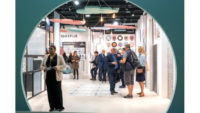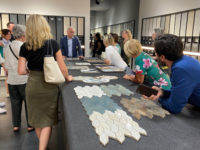I have been fortunate to be hosted by Tile of Spain on this trip several times in the past, and I have to say, it never disappoints. Not only is the trip well organized, but the association also goes to great lengths to showcase the best Spain has to offer -- from its architecture to many of its impressive ceramic tile factories to its fine cuisine.
This year, the trip kicked off in Barcelona, where the influence of Gaudi is noticeable throughout the city. On our first day, we visited Park Güell. Located in the upper part of Barcelona, the park offers breathtaking views of the city and is filled with the colorful whimsies of Gaudi. An attention-grabber for certain is the dragon fountain staircase at the entrance to the park -- clad in vibrant shades of colored mosaics. These mosaics also adorn a series of curved benches in the park's terraced area.
The technique that Gaudi used to achieve the broken mosaics which he so often used in his designs is referred to as trencadis. Our guide, who had been a local architect for many years, explained that Gaudi was considered crazy by many for his unconventional approach to design. For some, it was inconceivable why he would take perfectly good ceramic tile and shatter it into pieces. Not being swayed by opinion, Gaudi obviously proved his critics wrong with his magical creations that are visited by thousands from around the world.
Another stop our group made in Barcelona was to the studio of Ceramica Cumella, owned by ceramist Toni Cumella. With a team of 10 employees, the mission of Ceramica Cumella is to work with architects to develop their ideas into unique three-dimensional pieces for architectural projects.
"Our philosophy is that ceramics have their own personality," Cumella explained to our group. "The studio exists to work with architects and provide a solution."
Ceramica Cumella has worked with many renowned architects, including Renzo Piano, and the studio was involved with the restoration of Gaudi's Casa Batlló, with architect Josep Botey, and the restoration of Gaudi's Park Güell, with architects Elíes Torres & Martinez Lapena.
When touring the studio, the level of creativity is evident. There are many unique pieces that make you stop to wonder how they were achieved in ceramics.
After visiting both El Park Güell and Ceramica Cumella while in Barcelona, it left me considering the fact that thinking outside the box and going against conventional design can lead to unique and memorable work. If Gaudi had listened to his critics, he might not have the worldwide reputation that he has today. So it might just be worth it to go against the grain some time and dare to be different when designing your next project.






